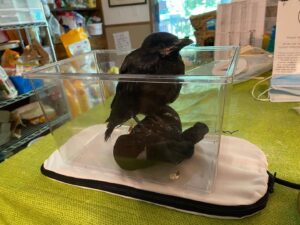
Eva Welch, DVM is a veterinarian in Hillsborough, NC. She was co-founder of Healing Paws Veterinary Hospital and is currently an active volunteer with Our Wild Neighbors, a wildlife rehabilitation organization. Both serve Hillsborough and the surrounding communities.
Assisi: Tell us about Our Wild Neighbor (OWN) and how and why it was started.
Dr. Welch: OWN is a local wildlife rehabilitation organization in Hillsborough, NC started by Linda Ostrand, the director. Our mission is to promote the understanding of nature and the protection of wildlife. With over 30 years of wildlife rehabilitation experience, Linda has grown OWN into a network of interns and volunteers that offers a 7-day-a-week direct resource for the surrounding community to triage and care for over 1000 juvenile or injured animals each year.
Assisi: How did you learn about Assisi Loop Therapy?
Dr. Welch: I first was introduced to Assisi Loop Therapy at a lecture on incorporating integrative  medicine during the 2018 ExoticsCon (the joint Association of Avian Veterinarians/Association of Exotic Mammal Veterinarians/Association of Reptile and Amphibian Veterinarians) annual conference).
medicine during the 2018 ExoticsCon (the joint Association of Avian Veterinarians/Association of Exotic Mammal Veterinarians/Association of Reptile and Amphibian Veterinarians) annual conference).
Assisi: Is there a particular case that convinced you of the power of targeted pulsed electromagnetic field (tPEMF) therapy?
Dr. Welch: In small animal practice, I had a feline patient with suspected IBD/chronic pancreatitis who was very sensitive to medications. Until trying the Assisi Loop, she would vomit unless given a daily antiemetic. She was difficult to medicate, so the owner was using transdermal medications. She improved after using the Loop and no longer required daily medication.
Assisi: How has Assisi Loop Therapy changed the way you rehabilitate wildlife animals?
Dr. Welch: It has given many patients a chance, especially head trauma cases. When the usual treatment is limited to just giving the animal some time, this is a safe, efficient way to give time a little boost. With the Assisi Loop Lounge, one device can be used multiple times a day on numerous patients. We are always saying, “Oh, let’s use the Loop on this animal!” with an “a-ha!” look on our faces.
Assisi: What are the most common conditions you’ve used the Loop to treat? Does any particular case stand out?
Dr. Welch: Head trauma from falls, hit-by-car incidents, limb fractures, wounds. In particular, an adult crow suspected to have sustained head trauma, presented to OWN unable to fly and demonstrating neurological symptoms. Upon therapy with the Assisi Loop Lounge 3-4 times a day, he improved dramatically and was released back into his established flock.
adult crow suspected to have sustained head trauma, presented to OWN unable to fly and demonstrating neurological symptoms. Upon therapy with the Assisi Loop Lounge 3-4 times a day, he improved dramatically and was released back into his established flock.
Assisi: Do you find that there are unique benefits to treating wild animals with Assisi Loop Therapy?
Dr. Welch: Absolutely! Wild creatures are fearful in the presence of humans. Wildlife patients can be treated in a quiet, comfortable environment–such as a small container covered with a towel, or the device can be placed under a crate for a larger patient. Stress can delay healing. By using a hands-off therapy, it benefits both the patient as well as the rehabber from potential injuries sustained during restraint.
As it activates the animal’s own anti-inflammatory process, patients require less medication (therefore less handling/stress). In addition, many drug doses for these patients are extrapolated, so the Assisi Loop provides a safe, easy treatment that can lower the risk of adverse effects associated with drugs on very young or wild species with limited species-specific pharmacokinetic data. Finally, as it accelerates healing, the patients can be released into their natural environment sooner.
